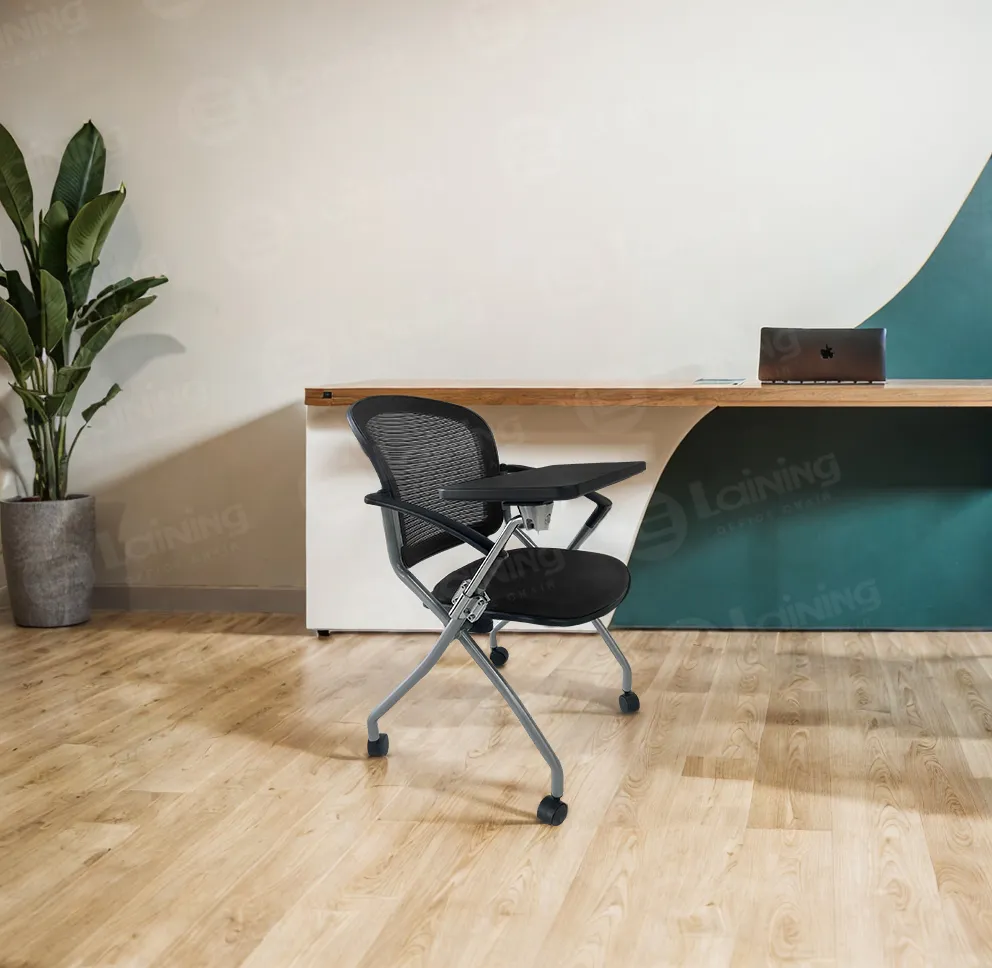Training Chairs Aim To Provide A Fully Functional And Flexible Workspace For Various Training, Educational, Or Collaborative Activities
Training chairs aim to provide a fully functional and flexible workspace for various training, educational, or collaborative activities. This design concept embodies the multiple demands of adaptability, comfort, and practicality in modern learning environments. Through carefully designed Training Chairs, institutions can optimize space utilization, enhance participants' learning experience, and thus improve training efficiency and overall effectiveness.

Functionality is the core consideration in the design of Training Chairs
An excellent trainee chair should not only provide basic seating functions, but also have the ability to facilitate writing and placing personal belongings. A common practice is to equip the seat with a foldable writing board for students to take notes and engage in group discussions. At the same time, the material and structure of the chair need to ensure sufficient load-bearing capacity and durability to cope with high-frequency use. In addition, some Training Chairs are equipped with mobile wheels for easy and quick layout adjustment, adapting to training activities of different scales and forms.
Flexibility is a key characteristic of Training Chairs
Modern training methods are becoming increasingly diverse, from traditional lecture style teaching to interactive workshops, and the requirements for spatial layout are also changing accordingly. The design of the trainer chair must be able to flexibly adapt to these changes. For example, stackable Training Chairs facilitate centralized storage when not needed, saving space. Chairs with connectors can be quickly combined into different arrays to meet the needs of group discussions or teamwork. This flexibility not only improves space utilization, but also provides greater freedom for organizers of training activities.
Comfort is an essential factor in the design of Training Chairs that cannot be ignored
Long term training activities can easily make participants feel tired and affect their learning outcomes. Therefore, the seats and backrests of the training chair should be designed with ergonomic curves to provide good support and comfort. Materials with good breathability can reduce stuffiness and improve comfort. Appropriate seat height and depth, as well as adjustable armrests, can meet the needs of different body types and sitting positions. A comfortable seating environment helps participants concentrate and improve learning efficiency.
In summary, foldable training chairs play an important role in training, education, and collaborative activities. By providing a fully functional, flexible, and comfortable workspace, Training Chairs not only improve space utilization but also enhance the learning experience for participants, thereby increasing the overall effectiveness of training activities. With the continuous development of educational concepts and technological advancements, future Training Chair designs will place greater emphasis on personalized customization and intelligent functionality, creating a more efficient and comfortable learning environment for learners.
Training Chairs FAQs
1: What are Training Chairs? What is the difference between it and a regular office chair?
1: Training chairs are designed specifically for collective learning, meetings, or collaboration scenarios, with the core difference being:
Lightweight and portable: Lightweight (usually<10kg), with armrests or stacking design, making it easy to quickly rearrange space.
Flexible configuration: Can be paired with a writing board, scroll wheel (silent wheel) or fixed foot, suitable for classrooms, conference rooms, training centers.
Durability: High density sponge or hard plastic material, suitable for high-frequency use.
Ordinary office chairs focus more on personal long-term comfort, but have lower efficiency in mobility and space adjustment.
2: How can Training Chairs improve collaboration efficiency?
2: Optimize team interaction through the following design:
- 360 ° rotation: facilitates face-to-face communication during group discussions.
- Foldable stacking (such as Stacking Chairs): Quickly free up space for activity rehearsals.
- Integrated writing board: Some models are equipped with foldable desktops that support note taking or electronic device use.
- Modular combination: It can be combined with a training table to form circular, U-shaped or other layouts (such as Herman Miller Caper Chair).
3: How to choose training chairs that are suitable for the training scenario?
3: Matching functions according to requirements:
Short term training (<2 hours): Choose hard plastic chairs or armless models to reduce costs.
Long term courses: prioritize breathable mesh and lumbar support (such as Steelcase Series 1).
Multi functional space: stacked loans+silent wheels (such as Sedus Stoll Top).
Attention: The chair legs should be scratch resistant to the floor (rubber foot pads), and the noise level should be below 50 decibels.
4: Is the comfort level of Training Chairs sufficient to support all day use?
4: Need to discuss on a case by case basis:
Basic model: Suitable for 13 hour meetings, but lacks lumbar support and is prone to fatigue from prolonged sitting.
High end models: Enhance comfort through adjustable height and tilted backrest (such as VS Verego), but at a higher cost.
Suggestion: Mixed configuration - the speaker uses ergonomic chairs, and the students use lightweight training chairs.
5: What are the techniques for maintaining and cleaning Training Chairs?
5: The key to extending lifespan:
- Material selection:
Mesh: Anti splash coating, wipe with a damp cloth.
Hard plastic: UV resistant material to prevent yellowing from sunlight.
- Structural maintenance: Regularly check for loose screw buckles (especially for stacked loans).
- Cleaning frequency: weekly disinfection is recommended for public spaces (alcohol spray will not damage PU skin).
share:
-
Comfortable Meeting Room Chairs: Ergonomic Seating Solutions for Global WorkspacesNotíciasNov.25,2025
-
Chairs Meeting Room: The Ultimate Guide to Choosing Ergonomic, Sustainable SeatingNotíciasNov.24,2025
-
The Global Appeal and Practical Benefits of Blue Meeting Room Chairs | Laining GlobalNotíciasNov.23,2025
-
Black Meeting Room Chairs: Durable, Ergonomic & Stylish Seating for Modern WorkspacesNotíciasNov.23,2025
-
Stackable Meeting Room Chairs - Durable, Efficient & Space-Saving SolutionsNotíciasNov.22,2025
-
Office Meeting Room Chairs – Comfort, Durability & Sustainability in Modern OfficesNotíciasNov.22,2025
-
Choosing the Best Office Chairs for Meeting Rooms: Comfort Meets StyleNotíciasNov.22,2025









